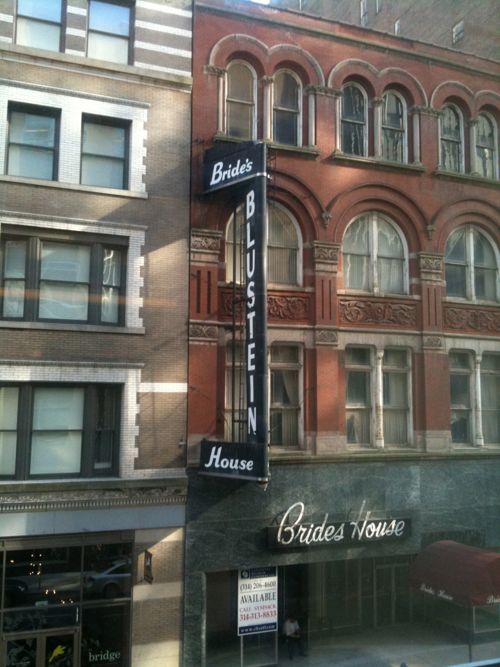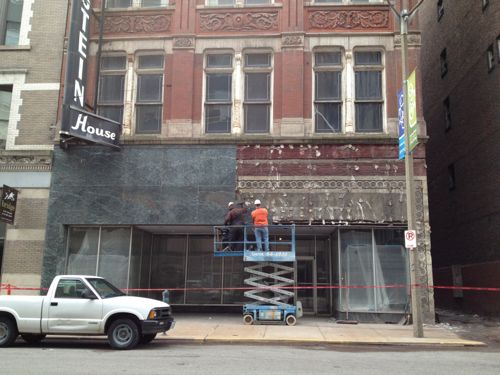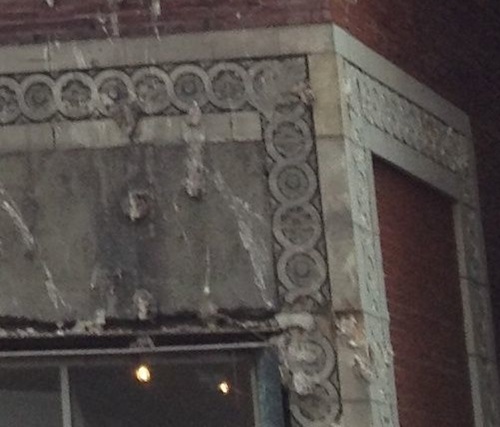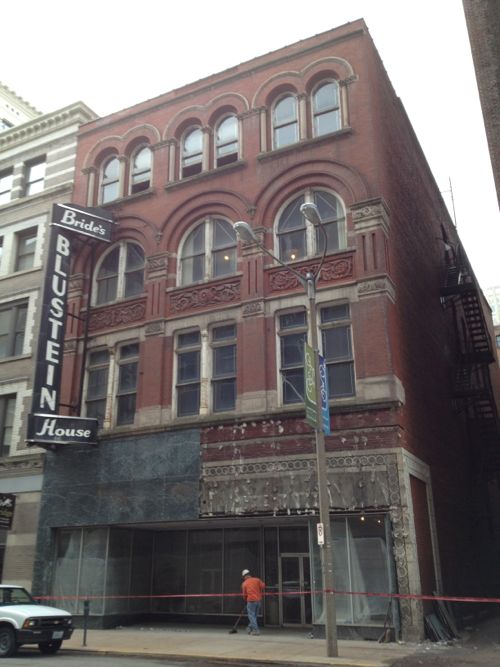Progress At 1010 Locust Street (aka Bride’s House)
The economy isn’t prefect but it is slowly improving. Smaller developers are still working on manageable sized projects such as the 4-story building at 1008-10 Locust St., known by many as Bride’s House. In August 2011 I posted about the building (see What a Handsome Bride). The 1886 building was listed on the National Register of Historic Places in 2010, read the application here.

In November 2012 the good news came that a local couple bought the building to rehab:
The biggest exterior change will be restoration of the street-level facade with separate entrances for a first-floor store and offices on the upper floors. The work will involve removing green granite panels installed in 1950. Cook hopes to reuse the panels in new shower stalls built for office tenants. He also plans to sell the two large “Bride’s House” signs over the current entrance.
The second floor remains available, but a retailer plans to occupy the street-level space and a marketing firm will lease the top two floors, said Patrick McKay, the Hilliker Corp. broker who represented P&F in the building’s purchase. (stltoday.com)
Earlier in the week I was passing the building and spotted workers removing those bland granite panels.



This project has me more excited than Ballpark Village phase one.
— Steve Patterson
It is small projects like this that give me hope for this ancient city. With each restoration of another historic building, another part of the puzzle that is our history is put back in its rightful place. And we take another step back from the wrecking ball mentality of the 1950 – 1970s, when everything old was hated and destroyed. We were once ashamed of these relics of our amazing past, now they are respected old friends.
It may be semantics, but St. Louis is not an ancient city, Rome and Athens are ancient cities. Also, please don’t be fooled about wrecking, Wrecking is probably not as vicious as it was up to the seventies, (there is far less to wreck). But wrecking is still going strong.
I have seen a number of solid buildings demolished on the South side near where I live in the last year or so, a three story mansard storefront on the corner of Nebraska and Cherokee for one, it was ripe for redevelopment in a growing area, yet it was demolished 6 months ago. Another across from Pius Catholic Church on McKee, and another one you can still see the debris on Indiana between Cherokee and Utah. You get the idea.
I think it was samizdat that cited others not long ago in his neighborhood. Also don’t forget the recent ongoing demo of the industrial building on Chouteau at Grand, still incomplete and in debris stages right this day. All sound buildings: please don’t imagine it has stopped.
OMG. There are still a lot of treasures to wreck, but hopefully a lot of it won’t happen. The tides are changing or slowing. Still……….this project is another leap forward. I understand jakeb’s comment. It’s like the younger St. Louis continues to uncover its greatness.
Hopefully is the operative word. Please understand, what has been wrecked is far beyond what is left. Sigfried Gideon in his book Space, Time, Architecture cites the riverfront in St. Louis, now demolished for the Arch, as some of the greatest cast iron architecture in the world. (book was published around 1941, I don’t have a copy in front of me so I am paraphrasing)
The previous losses have been grievous, but please, it may have slowed down, but you have to understand agencies such as CDA (Community Development Agency of St. Louis) prefer demolition and building new to this day. Nothing has changed,
if demolition has slowed, it is not because policies have changed, but because there is far less left to demolish.
Instead we have managed to fling the St. Louis region across acres and acres of farmland with suburban development by killing the city.
Look at the Slay/Reed mayoral race. What do they talk about in relation to really rebuilding St. Louis? What is their policy on demolition? You hear none of that, the major media makes sure of that and the blogs follow dutifully along, all wanting to be part of the mainstream and not willing to rock the boat.
But hey we really need to know when St. Louis was founded, this year or that, god damn right, let’s ask the hard questions and have a poll about it to boot.
You want to hear new policies from a mayoral election, forget it.
Where’s the discourse in ideas? There are none. The demolition nightmare will continue. You can pretend it is over, but it is not.
Ripe for redevelopment…..so what you’re saying is that the prior owners left the building to rot and then we’re suppose to be all giddy at being able to jump at the chance for redevelopment. Maybe if some of you would concentrate on why a building is left to rot first, Prevent That first. No. There is never any talk of that. No one ever took Peveley to task for leaving the City nor realized that an antiquated building couldn’t serve their needs. Never any talk of why people head to the suburbs. Maybe people don’t want to live 3 feet from your neighbor’s bedroom.
Many of the buildings on the Mid–Century Modernism list replaced other buildings, yet where it the complaining? Chicago’s downtown, and many other downtowns didn’t save every building and yet they are thriving. Some of these readers complain about some clinging to old-outdated ideas but don’t see themselves doing the same thing.
So I will leave with these last 2 thoughts: 1) if you don’t want a building torn down…..buy it, renovated it, oooooh, and maybe even live in it instead of just flipping it. and 2) Any city, including St. Louis, is so much more than just a bunch of buildings. Shame the suburbanites all you want, but until they are engaged and you find out why they prefer to live out west (or east), then you will never understand. People are what make a city.
excellent post _ thank you ! _ agree with jakeb
Wow. That detailing buried beneath the marble all these years is spectacular.
Glad you were able to catch this, perfect timing. Did you ask the workers about the signs?
No, I didn’t interrupt their work.
I am well and truly shocked to see that the stone wasn’t simply slabbed off, as one usually sees when mid-century cladding is removed. I would have been happy just to see the rest of the facade cleaned up, and the cladding remain (it’s not the worst I’ve seen). But this is a nice little bonus. One of the most handsome buildings DT; shame a previous owner removed the original facade parapet and cornice. Still, nicely done.
Hmmmm…hmmmmm…looks like they just left some granite off to the side there, in the alley…shame for it to go to waste…
Interesting how building fashion trends come and go…
Makes me wonder about the former SLDC building across the street and whether there might be something interesting under its ugly 1960’s cladding.
Makes me wonder about the former SLDC building across the street and whether there might be something interesting under its ugly 1960’s cladding.